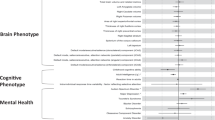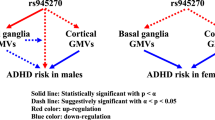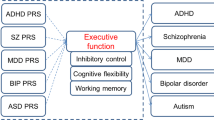Abstract
There are now large-scale data on which common genetic variants confer risk for attention deficit hyperactivity disorder (ADHD). Here, we use mediation analyses to explore how cognitive and neural features might explain the association between common variant (polygenic) risk for ADHD and its core symptoms. In total, 544 participants participated (mean 21 years, 212 (39%) with ADHD), most with cognitive assessments, neuroanatomic imaging, and imaging of white matter tract microstructure. We found that polygenic risk for ADHD was associated with symptoms of hyperactivity–impulsivity but not inattention. This association was mediated across multiple PRS thresholds by white matter microstructure, specifically by axial diffusivity of the right corona radiata, (maximum indirect effect β = −0.034 (CI: −0.065 to −0.01), by thickness of the left dorsomedial prefrontal (β = −0.029; CI: −0.061 to −0.0047) and area of the right lateral temporal cortex (β = 0.024; CI: 0.0034–0.054). In addition, modest serial mediation was found, mapping a pathway from polygenic risk, to white matter microstructure of the anterior corona radiata, then cognition (working memory, focused attention), and finally to hyperactivity–impulsivity (working memory β = −0.014 (CI: −0.038 to −0.0026); focused attention β = −0.011 (CI: −0.033 to −0.0017). These mediation pathways were diagnostically specific and were not found for polygenic risk for ASD or schizophrenia. In conclusion, using a deeply phenotyped cohort, we delineate a pathway from polygenic risk for ADHD to hyperactive–impulsive symptoms through white matter microstructure, cortical anatomy, and cognition.
This is a preview of subscription content, access via your institution
Access options
Subscribe to this journal
Receive 12 print issues and online access
$259.00 per year
only $21.58 per issue
Buy this article
- Purchase on Springer Link
- Instant access to full article PDF
Prices may be subject to local taxes which are calculated during checkout


Similar content being viewed by others
References
Demontis D, Walters RK, Martin J, Mattheisen M, Als TD, Agerbo E et al. Discovery of the first genome-wide significant risk loci for ADHD. bioRxiv 2017:145581.
Consortium IS. Common polygenic variation contributes to risk of schizophrenia that overlaps with bipolar disorder. Nature. 2009;460:748.
Wray NR, Goddard ME, Visscher PM. Prediction of individual genetic risk to disease from genome-wide. Genome Res. 2007;17:1520–8.
Di Martino A, Fair DA, Kelly C, Satterthwaite TD, Castellanos FX, Thomason ME, et al. Unraveling the miswired connectome: a developmental perspective. Neuron. 2014;83:1335–53.
Konrad K, Eickhoff SB. Is the ADHD brain wired differently? A review on structural and functional connectivity in attention deficit hyperactivity disorder. Hum Brain Mapp. 2010;31:904–16.
van Ewijk H, Heslenfeld DJ, Zwiers MP, Buitelaar JK, Oosterlaan J. Diffusion tensor imaging in attention deficit/hyperactivity disorder: a systematic review and meta-analysis. Neurosci Biobehav Rev. 2012;36:1093–106.
Chuang T-C, Wu M-T, Huang S-P, Weng M-J, Yang P. Diffusion tensor imaging study of white matter fiber tracts in adolescent attention-deficit/hyperactivity disorder. Psychiatry Res. 2013;211:186–7.
Sudre G, Choudhuri S, Szekely E, Bonner T, Goduni E, Sharp W, et al. Estimating the heritability of structural and functional brain connectivity in families affected by attention-deficit/hyperactivity disorder. JAMA Psychiatry. 2017;74:76–84.
Chen L, Hu X, Ouyang L, He N, Liao Y, Liu Q, et al. A systematic review and meta-analysis of tract-based spatial statistics studies regarding attention-deficit/hyperactivity disorder. Neurosci Biobehav Rev. 2016;68:838–47.
Valera EM, Faraone SV, Murray KE, Seidman LJ. Meta-analysis of structural imaging findings in attention-deficit/hyperactivity disorder. Biol Psychiatry. 2007;61:1361–9.
Friedman LA, Rapoport JL. Brain development in ADHD. Curr Opin Neurobiol. 2015;30:106–11.
Shaw P, Malek M, Watson B, Sharp W, Evans A, Greenstein D. Development of cortical surface area and gyrification in attention-deficit/hyperactivity disorder. Biol Psychiatry. 2012;72:191–7.
Peper JS, Brouwer RM, Boomsma DI, Kahn RS, Pol H, Hilleke E. Genetic influences on human brain structure: a review of brain imaging studies in twins. Hum Brain Mapp. 2007;28:464–73.
Jansen AG, Mous SE, White T, Posthuma D, Polderman TJ. What twin studies tell us about the heritability of brain development, morphology, and function: a review. Neuropsychol Rev. 2015;25:27–46.
Frazier TW, Demaree HA, Youngstrom EA. Meta-analysis of intellectual and neuropsychological test performance in attention-deficit/hyperactivity disorder. Neuropsychology. 2004;18:543.
Huang-Pollock CL, Karalunas SL, Tam H, Moore AN. Evaluating vigilance deficits in ADHD: a meta-analysis of CPT performance. J Abnorm Psychol. 2012;121:360–71.
Martinussen R, Hayden J, Hogg-Johnson S, Tannock R. A meta-analysis of working memory impairments in children with attention-deficit/hyperactivity disorder. J Am Acad Child Adolesc Psychiatry. 2005;44:377–84.
Boonstra AM, Oosterlaan J, Sergeant JA, Buitelaar JK. Executive functioning in adult ADHD: a meta-analytic review. Psychol Med. 2005;35:1097–108.
Martin J, Hamshere ML, Stergiakouli E, O’donovan MC, Thapar A. Neurocognitive abilities in the general population and composite genetic risk scores for attention‐deficit hyperactivity disorder. J Child Psychol Psychiatry. 2015;56:648–56.
Bidwell L, Willcutt EG, DeFries JC, Pennington BF. Testing for neuropsychological endophenotypes in siblings discordant for attention-deficit/hyperactivity disorder. Biol Psychiatry. 2007;62:991–8.
Kuntsi J, Eley TC, Taylor A, Hughes C, Asherson P, Caspi A, et al. Co-occurrence of ADHD and low IQ has genetic origins. Am J Med Genet Part B: Neuropsychiatr Genett. 2004;124:41–47.
Nigg JT, Gustafsson HC, Karalunas SL, Ryabinin P, McWeeney S, Faraone SV et al. Working Memory and Vigilance as Multivariate Endophenotypes Related to Common Genetic Risk for Attention-Deficit/Hyperactivity Disorder. J Am Acad Child Adolesc Psychiatry. 218; 57:175–82.
Posthuma D, Polderman TJ. What have we learned from recent twin studies about the etiology of neurodevelopmental disorders? Curr Opin Neurol. 2013;26:111–21.
Ronald A, Simonoff E, Kuntsi J, Asherson P, Plomin R. Evidence for overlapping genetic influences on autistic and ADHD behaviours in a community twin sample. J Child Psychol Psychiatry. 2008;49:535–42.
Taylor M, Charman T, Robinson E, Plomin R, Happé F, Asherson P, et al. Developmental associations between traits of autism spectrum disorder and attention deficit hyperactivity disorder: a genetically informative, longitudinal twin study. Psychol Med. 2013;43:1735–46.
Pennington BF, Ozonoff S. Executive functions and developmental psychopathology. J Child Psychol Psychiatry. 1996;37:51–87.
Kercood S, Grskovic JA, Banda D, Begeske J. Working memory and autism: a review of literature. Res Autism Spectr Disord. 2014;8:1316–32.
Martin J, Cooper M, Hamshere ML, Pocklington A, Scherer SW, Kent L, et al. Biological overlap of attention-deficit/hyperactivity disorder and autism spectrum disorder: evidence from copy number variants. J Am Acad Child Adolesc Psychiatry. 2014;53:761–70. e726.
Lionel AC, Crosbie J, Barbosa N, Goodale T, Thiruvahindrapuram B, Rickaby J, et al. Rare copy number variation discovery and cross-disorder comparisons identify risk genes for ADHD. Sci Transl Med. 2011;3:95ra75–95ra75.
Williams NM, Franke B, Mick E, Anney RJ, Freitag CM, Gill M, et al. Genome-wide analysis of copy number variants in attention deficit hyperactivity disorder: the role of rare variants and duplications at 15q13. 3. Am J Psychiatry. 2012;169:195–204.
Consortium C-DGotPG. Identification of risk loci with shared effects on five major psychiatric disorders: a genome-wide analysis. Lancet. 2013;381:1371–9.
Hamshere ML, Stergiakouli E, Langley K, Martin J, Holmans P, Kent L, et al. Shared polygenic contribution between childhood attention-deficit hyperactivity disorder and adult schizophrenia. Br J Psychiatry. 2013;203:107–11.
Wechsler D. Wechsler abbreviated scale of intelligence. San Antonio, TX: Psychological Corporation; 1999.
Wechsler D. Wechsler Abbreviated Scale of Intelligence (2nd ed.). San Antonio, TX: Psychological Corporation; 2011.
Wechsler D, Scales PI, Index VC Wechsler Preschool and Primary Scale of Intelligence—Fourth Edition. 2012.
Holdnack H. Wechsler test of adult reading: WTAR. San Antonio, TX: The Psychological Corporation; 2001.
Smith SM, Jenkinson M, Johansen-Berg H, Rueckert D, Nichols TE, Mackay CE, et al. Tract-based spatial statistics: voxelwise analysis of multi-subject diffusion data. Neuroimage. 2006;31:1487–505.
Wechsler D. Wechsler intelligence scale for children-WISC-IV. Psychological Corporation, 2003.
Woodcock RW, McGrew KS, Mather N. Woodcock-Johnson tests of achievement. Itasca, IL: Riverside Publishing; 2001.
Conners CK. Conners’ continuous performance test. North Tonawanda, NY: Multi-Health Systems; 2000.
Egeland J, Kovalik-Gran I. Measuring several aspects of attention in one test: the factor structure of conners’s continuous performance test. J Atten Disord. 2008;13:339–46.
Templ M, Kowarik A, Filzmoser P. Iterative stepwise regression imputation using standard and robust methods. Comput Stat Data Anal. 2011;55:2793–806.
Demontis D, Walters RK, Martin J, Mattheisen M, Als TD, Agerbo E et al. Discovery of the first genome-wide significant risk loci for ADHD. bioRxiv 2017.
Consortium ASDWGotPG. PGC-ASD summary statistics from a meta-analysis of 5,305 ASD-diagnosed cases and 5,305 pseudocontrols of European descent (based on similarity to CEPH reference genotypes) 2015.
SWGotPG Consortium, Ripke S, Neale BM, Corvin A, JTR Walters, Farh K-H, et al. Biological insights from 108 schizophrenia-associated genetic loci. Nature. 2014;511:421–7.
Euesden J, Lewis CM, O’Reilly PF. PRSice: polygenic risk score software. Bioinformatics. 2015;31:1466–8.
Chatterjee N, Wheeler B, Sampson J, Hartge P, Chanock SJ, Park J-H. Projecting the performance of risk prediction based on polygenic analyses of genome-wide association studies. Nat Genet. 2013;45:400–405e403.
Larsson H, Dilshad R, Lichtenstein P, Barker ED. Developmental trajectories of DSM-IV symptoms of attention-deficit/hyperactivity disorder: genetic effects, family risk and associated psychopathology. J Child Psychol Psychiatry. 2011;52:954–63.
Kuntsi J, Pinto R, Price TS, van der Meere JJ, Frazier-Wood AC, Asherson P. The separation of ADHD inattention and hyperactivity-impulsivity symptoms: pathways from genetic effects to cognitive impairments and symptoms. J Abnorm Child Psychol. 2014;42:127–36.
Willcutt EG, Pennington BF, Olson RK, DeFries JC. Understanding comorbidity: a twin study of reading disability and attention-deficit/hyperactivity disorder. Am J Med Genet Part B: Neuropsychiatr Genet. 2007;144B:709–14.
Wood AC, Rijsdijk F, Asherson P, Kuntsi J. Hyperactive-impulsive symptom scores and oppositional behaviours reflect alternate manifestations of a single liability. Behav Genet. 2009;39:447–60.
Weiler MD, Bernstein JH, Bellinger DC, Waber DP. Processing speed in children with attention deficit/hyperactivity disorder, inattentive type. Child Neuropsychol. 2000;6:218–34.
Pinheiro J, Bates D, DebRoy S, Sakar D, Team RC nlme: linear and nonlinear mixed effects models. R Package Version 31-1311 2018.
Tingley D, Yamamoto T, Hirose K, Keele L, Imai K mediation: R package for causal mediation analysis. J Stat Softw. 2014;1:5.
Hayes AF. Introduction to mediation, moderation, and conditional process analysis: a regression-based approach. Guilford Publications 2017.
Nikolas MA, Burt SA. Genetic and environmental influences on ADHD symptom dimensions of inattention and hyperactivity: a meta-analysis. J Abnorm Psychol. 2010;119:1–17.
McLoughlin G, Ronald A, Kuntsi J, Asherson P, Plomin R. Genetic support for the dual nature of attention deficit hyperactivity disorder: Substantial genetic overlap between the inattentive and hyperactive–impulsive components. J Abnorm Child Psychol. 2007;35:999–1008.
Muster R, Choudhury S, Sharp W, Sudre G, Shaw P. Mapping the neuroanatomic substrates of cognition in familial attention deficit hyperactivity disorder. Psychol Med. 2018;24:1–8.
Olesen PJ, Nagy Z, Westerberg H, Klingberg T. Combined analysis of DTI and fMRI data reveals a joint maturation of white and grey matter in a fronto-parietal network. Brain Res Cogn Brain Res. 2003;18:48–57.
Niogi SN, Mukherjee P, Ghajar J, McCandliss BD. Individual differences in distinct components of attention are linked to anatomical variations in distinct white matter tracts. Front Neuroanat. 2010;4:2.
Narayanan NS, Laubach M. Top-down control of motor cortex ensembles by dorsomedial prefrontal cortex. Neuron. 2006;52:921–31.
Venkatraman V, Rosati AG, Taren AA, Huettel SA. Resolving response, decision, and strategic control: evidence for a functional topography in dorsomedial prefrontal cortex. J Neurosci. 2009;29:13158–64.
Horst NK, Laubach M. The role of rat dorsomedial prefrontal cortex in spatial working memory. Neuroscience. 2009;164:444–56.
Eickhoff SB, Laird AR, Fox PT, Bzdok D, Hensel L. Functional segregation of the human dorsomedial prefrontal cortex. Cereb Cortex. 2014;26:304–21.
Andrews-Hanna JR, Reidler JS, Sepulcre J, Poulin R, Buckner RL. Functional-anatomic fractionation of the brain’s default network. Neuron. 2010;65:550–62.
Fassbender C, Zhang H, Buzy WM, Cortes CR, Mizuiri D, Beckett L, et al. A lack of default network suppression is linked to increased distractibility in ADHD. Brain Res. 2009;1273:114–28.
Wen X, Yao L, Liu Y, Ding M. Causal interactions in attention networks predict behavioral performance. J Neurosci. 2012;32:1284–92.
Rosenberg MD, Finn ES, Scheinost D, Papademetris X, Shen X, Constable RT et al. A neuromarker of sustained attention from whole-brain functional connectivity. Nat Neurosci. 2015;19:165–71.
Hagenaars SP, Harris SE, Davies G, Hill WD, Liewald DC, Ritchie SJ, et al. Shared genetic aetiology between cognitive functions and physical and mental health in UK Biobank (N=112 151) and 24 GWAS consortia. Mol Psychiatry. 2016;21:1624.
Savage JE, Jansen PR, Stringer S, Watanabe K, Bryois J, de Leeuw CA et al. GWAS meta-analysis (N=279,930) identifies new genes and functional links to intelligence. bioRxiv. 2017;184853.
Martin J, Hamshere ML, Stergiakouli E, O’Donovan MC, Thapar A. Genetic risk for attention-deficit/hyperactivity disorder contributes to neurodevelopmental traits in the general population. Biol Psychiatry. 2014;76:664–71.
Kuntsi J, Wood AC, Johnson KA, Andreou P, Arias-Vasquez A, Buitelaar JK, et al. Separation of cognitive impairments in attention-deficit/hyperactivity disorder into 2 familial factors. Arch Gen Psychiatry. 2010;67:1159–66.
Wood A, Asherson P, Van Der Meere J, Kuntsi J. Separation of genetic influences on attention deficit hyperactivity disorder symptoms and reaction time performance from those on IQ. Psychol Med. 2010;40:1027–37.
Acknowledgements
The study was funded by the intramural programs of the National Human Genome Research Institute and the National Institute of Mental Health. We thank participants and their families.
Author information
Authors and Affiliations
Corresponding author
Ethics declarations
Conflict of interest
The authors declare that they have no conflict of interest.
Additional information
Publisher’s note: Springer Nature remains neutral with regard to jurisdictional claims in published maps and institutional affiliations.
Supplementary information
Rights and permissions
About this article
Cite this article
Sudre, G., Frederick, J., Sharp, W. et al. Mapping associations between polygenic risks for childhood neuropsychiatric disorders, symptoms of attention deficit hyperactivity disorder, cognition, and the brain. Mol Psychiatry 25, 2482–2492 (2020). https://doi.org/10.1038/s41380-019-0350-3
Received:
Revised:
Accepted:
Published:
Issue Date:
DOI: https://doi.org/10.1038/s41380-019-0350-3
This article is cited by
-
Patterns of stressful life events and polygenic scores for five mental disorders and neuroticism among adults with depression
Molecular Psychiatry (2024)
-
Shared genetic etiology between ADHD, task-related behavioral measures and brain activation during response inhibition in a youth ADHD case–control study
European Archives of Psychiatry and Clinical Neuroscience (2024)
-
Rare copy number variants in males and females with childhood attention-deficit/hyperactivity disorder
Molecular Psychiatry (2023)
-
Youth Polygenic Scores, Youth ADHD Symptoms, and Parenting Dimensions: An Evocative Gene-Environment Correlation Study
Research on Child and Adolescent Psychopathology (2023)
-
Working memory and reaction time variability mediate the relationship between polygenic risk and ADHD traits in a general population sample
Molecular Psychiatry (2022)



